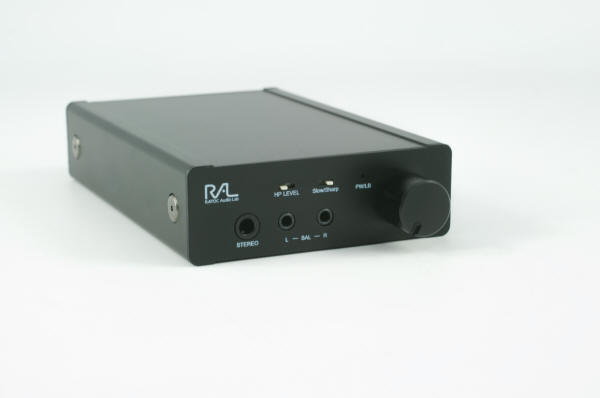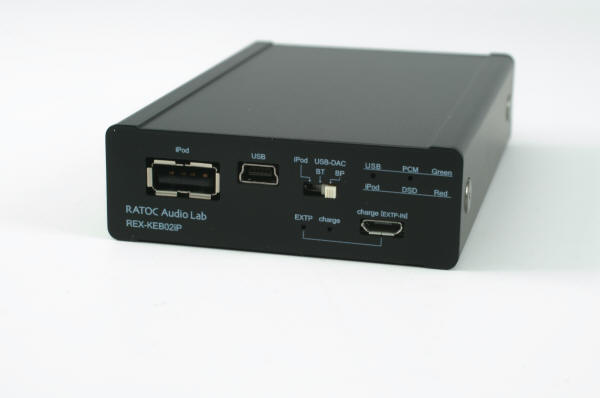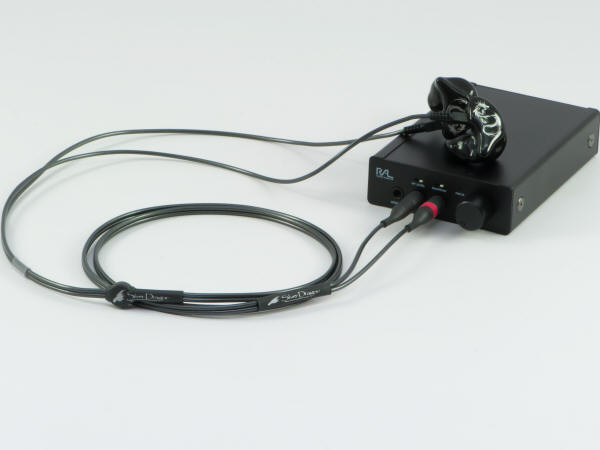You are reading the older HTML site
Positive Feedback ISSUE 78
Musings on Building a Digital Music Server: Catching Up on Portable, High-Resolution Audio with the RAL REX-KEB02iP
"A smile like the cartoon, tooth for a
tooth —"What's the Frequency, Kenneth?" by REM As Slim Pickens' character says in the film Dr. Strangelove, "Well, I've been to one world fair, a picnic, and a rodeo, and that's the stupidest thing I ever heard come over a set of earphones." By stupid, I mean stupid good. That was my reaction when I first heard the RAL KEB02iP driving my Silver Dragon-modified Beyerdynamic T5p's using a specially made balanced adapter. I was so impressed with the sound that I eventually bought the review sample from Moon Audio, using it to replace my Ray Samuels SR-71B, which I sold to fund the new purchase ($350 retail for the KEB02iP minus the cost of the balanced adapter and an AC adapter if you need or want either one). Please note that, while very good, the SR-71B is just an amplifier whereas the KEB02iP is a combined high-resolution, balanced DAC and balanced (or single-ended) headphone amplifier that can be driven up to 24/384 by your personal computer or strapped to an iPod or iPhone with the included black rubber band and connected via a short Lightening or 30-pin digital LOD, both again included with the KEB02iP.
The primary disadvantage of the KEB02iP is that it only last for five hours on a charge, but that's actually OK if you consider the life of an iPod Classic, which is much shorter when driving a DAC rather than going straight into an analog amplifier. Over the past few weeks, I listened to many albums stored in ALAC on my black iPod Classic strapped to the KEB02iP, using the short, 30-pin iDevice digital LOD that comes with the KEB02iP. I still had battery power left in both devices and the combination, driving my T5p's via the balanced adapter and five feet of Silver Dragon V3 cable, sounded great! I won't fall into the cliché of saying that the KEB02iP has no sound of its own. All audio devices have a sound of their own. However, the sound of the KEB02iP is extremely gentle and clear without being rolled off at either frequency extreme and, like a good tube system, never managed to annoy me. I could have listened even more without feeling fatigued, in fact, I did. After playing many iPod-based albums, I connected the KEB02iP to my 11" MacBook Air via the included USB cable and started playing another CD resolution ALAC album. I have to confess that, with the included USB cable, the sound seemed a little brittle and I did get a little annoyed with the treble, which seemed bright. However, I pulled out my one-meter Locus Design Polestar USB-A to USB-Mini B USB cable, and the sound of the KEB02iP really blossomed, becoming much richer with an all around better tonal balance and imaging as well as a really sweet treble, no annoyance factor at all. After I'd listened to the CD resolution album, I copied over a well-recorded 24/192 album from my iMac onto my MacBook Air and played that through the KEB02iP (which was now getting charged at the same time it was getting played via the USB connection) and, yes, the increased resolution was more than mildly audible through the KEB02iP. I wouldn't say it sounded as good as my Woo WA7 fed by my three-meter AudioQuest Cinnamon USB cable, but the overall improvement pushed it much closer than you might imagine and did some really remarkable things that weren't even possible in a combined handheld DAC and headphone amplifier, say, 3-5 years ago.
One of the advantages of the KEB02iP is that it comes with cables for both 30-pin and Thunderbolt devices, so if you've given up using an iPod, particularly now that the Classic has been discontinued, or if you just don't want to limit yourself to the 64GB maximum capacity of the iPod Touch, you can use a 128GB iPhone 6 not only as a phone and a PDA, but you can put it in airplane mode, connect it to the KEB02iP, and have a high-capacity storage device for just playing music with very high quality without having to pay $2500 for an Astell&Kern AK240. There's no doubt that AK240 is an extraordinary device (I've never heard one so I can only speak so much about its sound one way or another), but if you already own an iPhone with a 30-pin or Thunderbolt connector on it, you can buy a KEB02iP with everything you need (apart from a decent pair of headphones or IEM's) for $350 and be set for high-quality sound even if it's not all high-resolution, which is definitely not always directly correlated with high quality in my experience. In fact, the portable headphone-based system that sounds the closest to my reference Audio Note system is a 180GB iPod Classic, an original AlgoRhythm Solo, an original ALO Continental (a potable tube hybrid headphone amplifier), and a pair of Ultrasone Edition 8's, all using one form or another of Moon Audio Silver Dragon cable. You can't count just on numbers. You just need to avoid lossy compression and listen carefully. It's like DSLR's. I originally bought a Canon 20D at the recommendation of a friend, then I saw that you could get the 5D, which used a full-frame sensor, for not a lot more money. I asked my friend about why he didn't suggest the 5D, and he said it was because it didn't have that many more megapixels than the 20D; however, from my perspective, I liked the idea of having a full-frame sensor for practical reasons and it turned that, despite the number of megapixels, the larger sensor had larger pixels which resulted in lower noise, particularly in low-light situations, and higher overall image quality even though none of that was implied by, "the numbers". It's not the 1970's, yet sometimes we treat numerical resolution (e.g., 24/192 versus 16/44.1) the same way we used to ask the local stereo dealer about how much THD (Total Harmonic Distortion) a given amplifier had, as if that explained everything. Personally, I find it embarrassing. I will say that, with certain devices, such as my Woo WA7 (soon to be accompanied by a WA7tp), that 24/176.4 files do tend to sound better than 16/44.1 files, but that's not always the case and I would guess that the WA7tp (the tube power supply for the WA7) will make everything sound better, regardless of its numerical resolution. Speaking of resolution, though, given that the KEB02iP goes up to 24/384 but does not appear to support DSD, you might want to convert some of your DSD files to PCM files so that you can play them, at least on a MacBook Air or Pro. My earlier article discussing this subject suggested that DSD Master was the best application to use for conversion; however, I overlooked the fact that Pure Music also converts DSD files to PCM files and loads them into iTunes automatically. Pure Music (2.X) takes a little bit longer to process the files and favors 24/88.2 over 24/176.4 for standard resolution DSD (.dsf) files, plus—if memory serves me correctly—DSD Master automatically brought over more metadata, at least the album artwork. The net result, though, is that DSD files converted to PCM files using Pure Music do sound better than files processed with DSD Master. There's a richer quality to the resultant music with more definition and depth. So my apologies to Rob at Channel D for overlooking this capability built into Pure Music, the precision Swiss Army Knife of music file pre-processing applications for the Mac.
I wanted too hear how the KEB02iP sounded with my JHAudio JH 16 Pro's. The KEB02iP has an output level switch on it and I use the high setting with my T5p's to ensure I have enough output to play them at a satisfying level without cranking the volume knob all the way up, but my JH 16 Pro's are awfully sensitive particularly with the Silver Dragon IEM cable on them, which adds about 3dB of gain, so I figured the low setting would make sense. I can only run the JH 16 Pro's single-ended with the cable that I have, but I don't want to imply that balanced is inherently better than single-ended. I just found that, with the KEB02iP and T5p combination, spending a little extra money on the specially-made balanced adapter was worth the cost in terms of sound quality for that particular combination, partly because the output of the KEB02iP's DAC is balanced so feeding that directly into a balanced amplifier section has many advantages over using, say, the RSA SR-71B as a balanced amplifier but letting its phase splitter convert the single-ended output of my iPod Classic into a balanced signal. I feel embarrassed to admit that, no matter how many ways I tried, I just couldn't insert my JH 16 Pro's into either my left or right ears. Then it occurred to me that red was for the right ear and blue for the left ear and that I had been trying to put things in backwards for the better part of an hour. After I corrected that, they both went in right away, but I had a combination earwax/low-power failure, so I had to fix both of those before I could continue, which took a while. Thank goodness for Audio-Wipes. When I had cleaned up the JH 16 Pro's plus charged the iPod Classic and the KEB02iP, I was ready one more time to try the KEB02iP driving IEM's. This time, everything worked perfectly including the fact that both IEM's slipped in place just like they should and both devices had plenty of power. I even left the TV playing out loud in the background to simulate the ambient noise of, say, an airplane or an airport. I selected the album Paper Airplane by Allison Krauss and Union Station, and as long as it was playing, I heard no ambient noise, just an extremely pleasurable rendition of the music on the tiny magnetic drive inside my iPod Classic with tons or warmth and detail and a sweet, soft treble, pretty much just exactly like my T5p's. Just for fun, I switched over to my reference album, The New Bossa Nova by Luciana Souza, and it sounded flawless as well. So I felt extremely happy. I could have listened to music all night long. Obviously, for $350, the KEB02iP is a really remarkable value particularly if you happen to have an old iPod, higher-capacity iPhone, or personal computer with a good USB cable hanging around. It's not just a less expensive version of a truly fine sounding portable music player, it's also a really cool portable DAC and its only real downsides, apart from it requiring a third-party AC adapter (like the adapter made for the iPad Air) if you mind using your computer's USB port as a charger, are that it only runs five hours on a charge and most of the documentation comes in Japanese. However, the manuals can be found online and Google Translate works well. So no worries there. There are battery boosters out there as well and although I know my iPod Classic will only run in digital mode for about five hours itself, my iPhone might last a little bit longer. I just didn't get a chance to try it. So let's suppose you have a good pair of IEM's or high-end, easier-to-drive headphones along with an old SR-71B with a good LOD and an iPod Classic and, rather than dropping $2500 on the Astell & Kern AK240 and throw out your iPod Classic, you just want to drop $350 into a really high-quality balanced DAC and balanced (or single-ended) headphone amplifier with a smooth, sweet, clear sound, you need look no further! The RAL KEB02iP will suit you nicely. Kindest regards, Andy
Moon Audio
|




